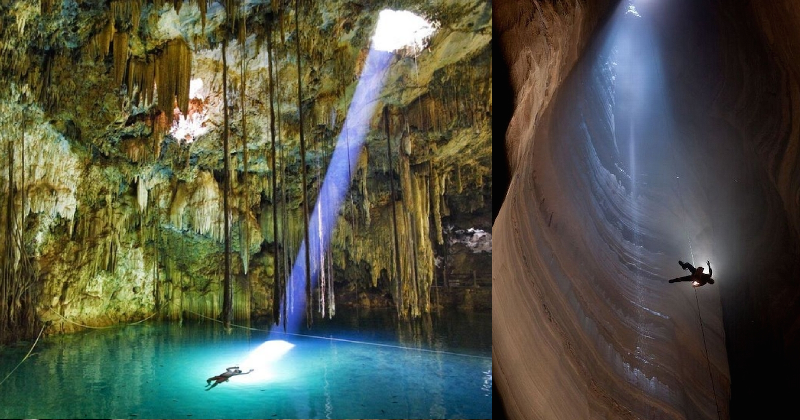Voronya Cave, often regarded as the closest point to the center of the Earth, aligns with one of Jules Verne's cherished dreams as depicted in his 1864 novel, "Journey to the Center of the Earth," where the protagonist yearns to explore the Earth's interior. While Veryovkina Cave doesn't plunge to the depths imagined by Verne, it does take us to the nearest known point to the Earth's center.
 With a staggering depth of approximately 2,212 meters, Veryovkina Cave holds the distinction of being the deepest cave in the world. Situated in the pass between the Krepost and Zont mountains within the Abkhazia region—an independent state recognized as part of Georgia—the cave was initially discovered in 1968 by speleologists from Krasnoyarsk, who ventured to a depth of 115 meters.
With a staggering depth of approximately 2,212 meters, Veryovkina Cave holds the distinction of being the deepest cave in the world. Situated in the pass between the Krepost and Zont mountains within the Abkhazia region—an independent state recognized as part of Georgia—the cave was initially discovered in 1968 by speleologists from Krasnoyarsk, who ventured to a depth of 115 meters.
In 1986, a Moscow-based group, led by Oleg Parfenov, surpassed previous explorations by reaching an impressive depth of 440 meters. Subsequent expeditions by the Perovo-Speleo group, starting in 2015, continually pushed the boundaries, revealing that the cave was even deeper. These efforts culminated in a groundbreaking achievement in March 2018, when a record depth of 2,212 meters was reached, unveiling an extensive underground tunnel system spanning more than 6,000 meters.
Formerly recognized as Krubera Cave, Voronya Cave was initially considered the deepest cave on Earth, though it is now commonly acknowledged as the second deepest. Situated in the Republic of Georgia, this natural marvel has gained renown among cavers for its formidable challenges and impressive subterranean depth.
Krubera Cave: Depths and Wonders
Krubera Cave, situated in the Arabika Massif of the Gagra Range in the Western Caucasus, offers stunning views of the Black Sea. Although not the sole cave in the area, it holds significance as the second deepest cave globally, trailing closely behind the Voronya Cave system.
Measuring approximately 7,200 feet (2,200 meters) from the entrance to the deepest explored point, Krubera Cave surpasses the third deepest cave in the Austrian Alps by a mere 80 feet (24 meters). The entrance, surprisingly narrow for its expansive interior, was only fully discovered in 2001.
The cave's geological composition, primarily limestone from the Cretaceous and Jurassic ages, contributes to its unique features. Inside, numerous underground springs, pools, and interconnected passageways characterize the system. Notable among them is the Cascade pit, plunging over 500 feet (152 meters) deep with a water pool at the bottom. The cave also reveals freezing sumps and water cascades, adding to its allure.
Unveiling Depths through Time
Krubera Cave remained untouched until the 1960s, known to locals who lacked the means to explore its mysteries. Soviet speleologists, the first to delve into its depths, identified an unusually deep underground system and named it after Alexander Kruber, a prominent Russian geographer and speleology pioneer. Alternatively known as Crow's Cave (Vronja) due to the numerous crows nesting nearby, the cave saw little exploration until the 1980s when Ukrainian speleologists conducted a breakthrough expedition, reaching a depth of 900 feet (274 meters).
Post-Soviet Union collapse, exploration stagnated for two decades until an American expedition reignited interest in 2001. Over subsequent Krubera Cave expeditions, more pits, meanders, tunnels, and passages were discovered, with underground divers exploring its water bodies.
In 2012, a Ukrainian diver set a world record, reaching Krubera's deepest point at over 2,000 feet (600 meters). However, in 2017, a team confirmed that Veryovkina Cave in Abkhazia claimed the title of the world's deepest cave.
Challenges and Access Restrictions
Gagra, Abkhazia, situated in a breakaway region under the control of the Russian Federation and local allies, poses access challenges to Krubera Cave. The region cannot be entered directly from Georgia, requiring permission to access Abkhazia through Russia. Due to its perilous nature, only highly trained experts should venture into Krubera Cave, emphasizing the need for caution. Amateurs and adventure enthusiasts, however, can explore the surrounding area near the cave entrance.
